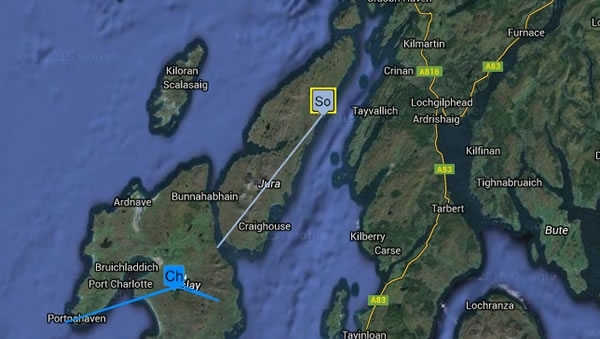Soval was tagged in February 2015 on Islay and proceeded to migrate to Östersund in Sweden. This was, by all accounts, a very typical spring migration. Soval remained in Sweden for the rest of the summer and was lost in the autumn when his tag’s batteries went flat.
In early 2016, a spell of spring sunshine gave the tag the boost it required and it suddenly started transmitting again. This was the first confirmation that we had received that Soval had made it back to the Western Isles. This was great news; Soval’s tag recharging ahead of the spring migration meant we would have the chance to track him on a second outward journey.

After one potentially-spurious* fix on Islay, Soval transmitted consistently from the neighbouring isle of Jura. We were expecting that, in the coming weeks, we would see Soval head for the Scottish mainland, cross over to its east coast and embark on a long oversea flight to Scandinavia.
We have received plenty of data from Soval since then but these only show small-scale local movements on Jura with no signs of any migratory behaviour. We know that Soval was a migrant as he has been to Sweden at least once before so it’s very interesting to witness this change to a more sedentary lifestyle.
What makes this all the more interesting is that Soval is not the only bird to do this this year. Nastasia and Olwen, tagged in Ireland and Wales respectively, have both migrated to Russia in the past. This year Nastasia has moved no further than Wales and Olwen is at a site in Lincolnshire where he has spent the whole winter.
Including Soval, Nastasia and Olwen, we have recorded this behaviour five times in the five years Woodcock Watch has been running. It’s clearly not that common – but five out of around sixty birds also suggests that it’s not incredibly rare either. We would guess that these are probably old, sick or injured birds that may be well enough to survive but cannot reach the high level of fitness that a long migration requires.
These migrant birds that ‘turn resident’ are distinct from our true resident breeding population which will have hatched here in the UK and do not have the biological impulse to migrate. But it is interesting to think that amongst this native resident population there may be a few foreign woodcock that, for whatever reason, didn’t return to Scandinavia or Russia.
*When the tag’s batteries recharge after a long period of dormancy the first few fixes are usually fairly suspect. They soon increase in accuracy as the tag finds its bearings.